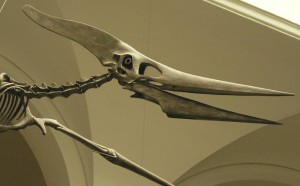Updated on: 28/03/2022
Pteranodon is an extinct genus of pterosaurs that lived around 85-75 million years ago. Pteranodon species existed for over four million years. Even though Pteranodon is frequently associated with dinosaurs, it was a flying reptile. It is often mistaken as Pterodactyl.
| Kingdom: | Animalia |
| Phylum: | Chordata |
| Order: | Pterosauria |
| Suborder: | Pterodactyloidea |
| Family: | Pteranodontidae |
| Subfamily: | Pteranodontinae |
| Genus: | Pteranodon |
| Species: | Pteranodon longiceps (Type Species) Pteranodon sternbergi |
| Pronunciation: | Teh-RAN-uh-DON |
| Name Meaning: | Winged and Toothless |
| Geological Time Period: | Late Coniacian to early Campanian stages, Cretaceous period |
| Size: | Length – 1.5 to 2 ft (from tip of the beak to tail) Height – 5 to 6 ft (tall at the hips) |
| Wingspan: | 25 to 33 ft wide |
| Weight: | 50 to 60 lbs |
| Range/Location: | North America and Europe |
| Habitat: | Coastal Environment |
| Diet: | Carnivore or Piscivore |
| Birth Type (Reproduction): | Eggs |
| Locomotion: | Quadrupedal (arguably bipedal) |
Pteranodon was the very first known pterosaur outside Europe. First fossil remains were found in the Late Cretaceous Smoky Hill Chalk deposits of Kansas, United States, by Othniel Charles Marsh in 1870. This genus is known from extremely well-represented fossil samples. As of now, more than 1000 skeletal remains have been unearthed. The fossil materials represent both male and female of various age groups and species. Fragmentary fossils assigned to this genus have also been found in Skåne, Sweden.
Pteranodon had a giant pelican like appearance. Their wingspan was larger than any known bird species. One of its distinctive features was its cranial crest projecting upward and then turning backward from the skull. It is believed that the long, light-weight, bony crest helped in balancing their beak and jaws. Some researchers stated that it was probably something to do with sexual dimorphism or probably used in attracting mates during the breeding season. In fact, it has also been said that they worked as a stabilizer or rudder while flying. They had large brains and good eyesight. Pteranodon had no teeth on their beaks. Their upper beak, which was longer than the lower one, was curved upward. It had strong hind legs. Their wings were covered with a leatherlike tissue layer which stretched from the top of its legs to its fourth fingers. It had hollow bones and it also possessed a short tail. Their body was probably covered with fur.

Researchers believe that they were primarily fish eater. The probably scooped out fish from the water by dipping their beaks into the water while in low flight and swallowed them whole. They also fed on mollusks, crabs and insects; and scavenged on the carcasses of dead animals. It is believed that they primarily dwelt on offshore rookeries, safe from land predators. Pteranodon was modern-day albatross like flyer. But, unlike the albatross, it occasionally required rapid burst of flapping. In fact, studies have shown that Pteranodon were capable of flapping flight to an extent, rejecting the initial suggestions that they could just glide. Like other pterosaurs species, they also took off from a quadrupedal position getting all of the energy generated by the forelimbs.
| Pterodactylus occidentalis | Reclassified as Pteranodon occidentalis |
| Pterodactylus ingens | Reclassified as Pteranodon ingens |
| Pterodactylus velox | Nomen dubium |
| Ornithochirus umbrosus | Nomen dubium |
| Ornithochirus harpyia | Nomen dubium |
| Pterodactylus umbrosus | Reclassification of Ornithochirus umbrosus |
| Pteranodon longiceps | Valid |
| Pteranodon ingens | Nomen dubium |
| Pteranodon occidentalis | Nomen dubium |
| Pteranodon velox | Nomen dubium |
| Pteranodon gracilis | Reclassified as Nyctosaurus gracilis |
| Pteranodon comptus | Nomen dubium |
| Pteranodon nanus | Reclassified as Nyctosaurus nanus |
| Ornithocheirus umbrosus | Reclassified as Pteranodon umbrosus |
| Ornithocheirus harpyia | Reclassified as Pteranodon harpyia |
| Pteranodon umbrosus | Nomen dubium |
| Ornithostoma ingens | Synonym of Pteranodon ingens |
| Ornithostoma umbrosum | Synonym of Pteranodon umbrosus |
| Pteranodon oregonensis | Reclassified as Bennettazhia oregonensis |
| Pteranodon sternbergi | Valid |
| Pteranodon marshi | Synonym of Pteranodon longiceps |
| Pteranodon bonneri | Reclassified as Nyctosaurus bonneri |
| Pteranodon walkeri | Synonym of Pteranodon longiceps |
| Pteranodon (Occidentalia) eatoni | Synonym of Pteranodon sternbergi |
| Pteranodon eatoni | Synonym of Pteranodon sternbergi |
| Pteranodon (Longicepia) longicps [sic] | Synonym of Pteranodon longiceps |
| Pteranodon (Longicepia) marshi | Synonym of Pteranodon longiceps |
| Pteranodon (Sternbergia) sternbergi | Reclassified as Pteranodon (Geosternbergia) sternbergi |
| Pteranodon (Sternbergia) walkeri | Reclassified as Pteranodon (Geosternbergia) walkeri |
| Pteranodon (Pteranodon) marshi | Synonym of Pteranodon longiceps |
| Pteranodon (Occidentalia) occidentalis | Synonym of Pteranodon occidentalis |
| Pteranodon (Longicepia) ingens | Synonym of Pteranodon ingens |
| Pteranodon (Pteranodon) ingens | Synonym of Pteranodon ingens |
| Pteranodon (Geosternbergia) walkeri | Synonym of Pteranodon longiceps |
| Pteranodon (Geosternbergia) sternbergi | Synonym of Pteranodon sternbergi |
| Pteranodon orientalis | Reclassified as Bogolubovia orientalis |
| Geosternbergia walkeri | Synonym of Pteranodon sternbergi |
| Geosternbergia sternbergi | Synonym of Pteranodon sternbergi |